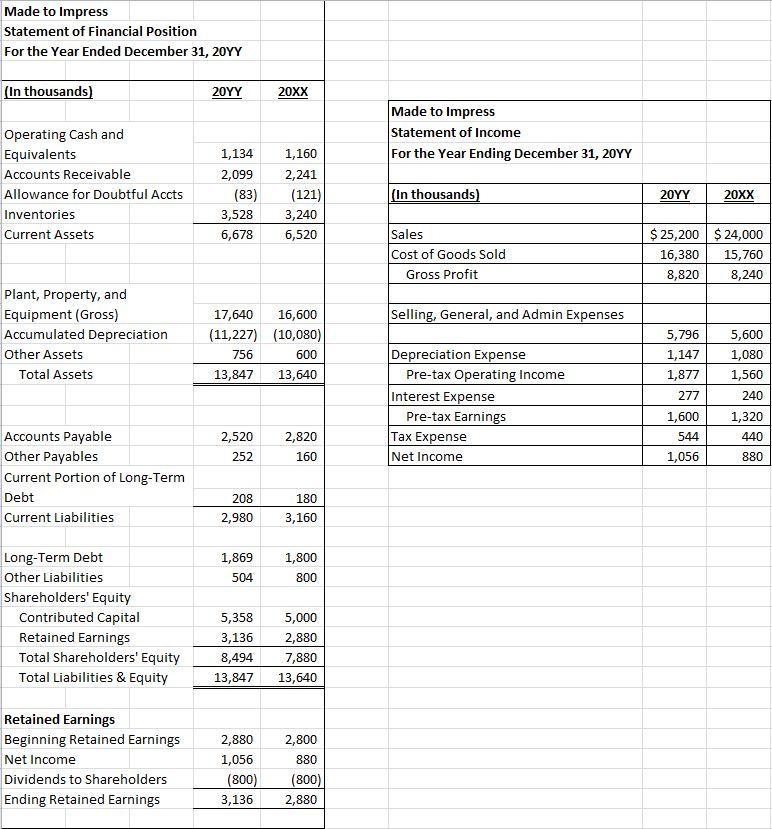Answered step by step
Verified Expert Solution
Question
1 Approved Answer
You and your team have now completed all of the field work for the audit at made to Impress, Inc. The company provided you the
You and your team have now completed all of the field work for the audit at made to Impress, Inc. The company provided you the attached financial statements, but you have adjustments that you are going to propose. You feel that some of them are small and inconsequential, but there are others that you consider to be material for the overall financial statement presentation. The following entries have been proposed:
- Payroll expenses for the warehouse were not accrued at the ending of the year. Those costs are $14,250.
- Depreciation expenses were reported $8,500 higher than your recalculations.
- Fifty percent of the phone and internet bill applies to January-20ZZ. This invoice totals $2500.00.
- Invoices that were received and booked in early January 20ZZ were applicable to 20YY. These invoices total $24,555. Of this amount, $17,800 were SG&A related, and the remaining amount was for inventory that would eventually be sold to its customers.
- $15,000 of the “Other Assets” should have been classified as “Operating Cash and Equivalents”.
- Based upon your sampling, you are confident that sales are being overstated overstated by 7%.
- You tabulated all of the returned merchandise that was sitting in the corner of the warehouse and found the cost of those items was $104,000.
- Assuming that MTI accepts all of the adjustments, you are to recreate what the restated financial statements would be as if these entries have been made.
- After you have completed all of the adjustments, review the gross profit percentage. Assume that the ratio in 20XX was reasonable, and there were not any major changes in the sales mix in 20YY. Do you feel that you should do additional field work to justify the gross profit margin?
- Calculate the following metrics based on the new financial statements:
- Quick ratio
- Current ratio
- Receivables turnover (assume 90% of sales were on credit)
- Net profit margin
- Inventory turnover ratio
- Return on beginning equity
- Debt/Equity Ratio
- Based upon your professional judgment and your observations with the sales and collection cycle, do you feel that the Allowance for Doubtful Accounts balance is sufficient? Remember to take into consideration your knowledge about the warehouse operations, the potentially overstated sales, and the questionable internal controls. You have also looked up the industry average for similar companies and have found the average amount to be 3.75% of Gross Accounts Receivable at the end of each company’s respective year end. Give your basis for your answer.
- When you present these adjustments to MTI, to whom will you specifically submit them?
- If MTI accepts all of these adjustments and enters them into their accounting system, what type of opinion will you give?
- If MTI decides that they will not book any of the adjustments, what opinion will you give based upon your audit?
- If MTI wants an unqualified opinion but does not want to hassle with all of the entries, which adjustments are not negotiable with regards to materiality, and which adjustments will you let slide while still giving an unqualified opinion? Please give a basis for your assessment on each of the entries that you mandate MTI accept, in order to receive an unqualified opinion.

Made to Impress Statement of Financial Position For the Year Ended December 31, 20YY (In thousands) Operating Cash and Equivalents Accounts Receivable Allowance for Doubtful Accts Inventories Current Assets Plant, Property, and Equipment (Gross) Accumulated Depreciation Other Assets Total Assets Accounts Payable Other Payables Current Portion of Long-Term Debt Current Liabilities Long-Term Debt Other Liabilities Shareholders' Equity Contributed Capital Retained Earnings Total Shareholders' Equity Total Liabilities & Equity Retained Earnings Beginning Retained Earnings Net Income Dividends to Shareholders Ending Retained Earnings 20YY 1,134 2,099 (83) 3,528 6,678 2,52 252 17,640 16,600 (11,227) (10,080) 756 600 13,847 13,640 1,869 504 20XX 2,880 1,056 1,160 2,241 (800) (121) 208 180 2,980 3,160 3,136 3,240 6,520 2,820 160 5,358 5,000 3,136 2,880 8,494 7,880 13,847 13,640 1,800 800 2,800 880 (800) 2,880 Made to Impress Statement of Income For the Year Ending December 31, 20YY (In thousands) Sales Cost of Goods Sold Gross Profit Selling, General, and Admin Expenses Depreciation Expense Pre-tax Operating Income Interest Expense Pre-tax Earnings Tax Expense Net Income 20YY $ 25,200 16,380 8,820 5,796 1,147 1,877 277 1,600 544 1,056 20XX $ 24,000 15,760 8,240 5,600 1,080 1,560 240 1,320 440 880
Step by Step Solution
★★★★★
3.34 Rating (157 Votes )
There are 3 Steps involved in it
Step: 1
Solution SInce it is not clearly specified as which year is current year It is assumed that the curr...
Get Instant Access to Expert-Tailored Solutions
See step-by-step solutions with expert insights and AI powered tools for academic success
Step: 2

Step: 3

Ace Your Homework with AI
Get the answers you need in no time with our AI-driven, step-by-step assistance
Get Started


